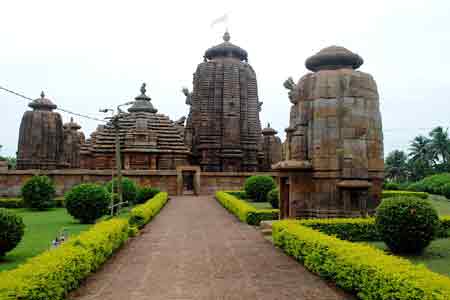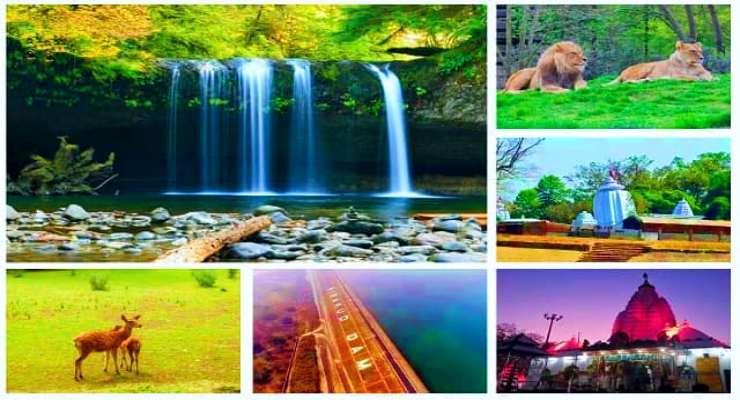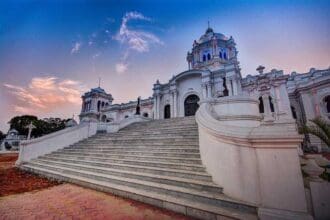Nestled in the eastern Indian state of Odisha, Jajpur is a district steeped in history, spirituality, and natural beauty. Often referred to as the “Land of Temples,” Jajpur has been a significant center of Hindu pilgrimage for centuries. From ancient shrines that echo tales of devotion to serene riverside landscapes that rejuvenate the soul, Jajpur offers a diverse range of experiences for travelers. In this comprehensive guide, we will explore the top 5 places to visit in Jajpur , delving into their historical significance, cultural importance, and why they deserve a spot on your travel itinerary.
1. Biraja Temple: The Sacred Abode of Goddess Durga
A Spiritual Haven for Devotees
The Biraja Temple , located in the heart of Jajpur town, is one of the most revered Shakti Peethas in India. Dedicated to Goddess Durga, this temple holds immense religious significance for Hindus. According to legend, it is believed that the navel (nabhi) of Sati, the consort of Lord Shiva, fell here, making it a sacred site for devotees.
The temple’s architecture reflects the traditional Kalinga style, with intricate carvings and sculptures adorning its walls. Inside, the sanctum sanctorum houses the idol of Goddess Biraja, depicted as Mahishasuramardini (the slayer of the buffalo demon). Pilgrims from across the country flock to this temple to seek blessings and perform rituals.
Festivals and Rituals
One of the highlights of visiting the Biraja Temple is experiencing its vibrant festivals. Durga Puja and Navratri are celebrated with great fervor, attracting thousands of devotees. During these festivals, the temple premises come alive with colorful decorations, devotional music, and elaborate rituals. The Boita Bandana festival, observed during Kartik Purnima, is another unique event where devotees float miniature boats in the nearby Brahmani River to honor ancient maritime traditions.
Tips for Visitors
- Dress modestly and remove footwear before entering the temple premises.
- Early mornings and evenings are ideal times to visit, as the weather is pleasant and the temple is less crowded.
- Photography may be restricted inside the sanctum sanctorum, so check with temple authorities beforehand.
Exploring the Surrounding Area
The Biraja Temple is surrounded by several smaller shrines and ponds, each with its own mythological significance. The Biraja Kunda , a sacred pond near the temple, is believed to have healing properties. Devotees often take a dip in its waters before offering prayers at the main shrine.
For those interested in history, the temple complex also houses ancient inscriptions and relics that provide insights into the region’s past. Guided tours led by local historians are available for visitors who wish to delve deeper into the temple’s rich heritage.
In-Depth Exploration of Biraja Temple
To fully appreciate the magnificence of the Biraja Temple, it’s essential to understand its historical and architectural context. Built during the reign of the Bhauma-Kara dynasty in the 9th century, the temple underwent several renovations under subsequent rulers, including the Somavamsis and the Gajapatis. Each era left its mark on the structure, resulting in a harmonious blend of styles that reflect Odisha’s rich artistic legacy.
The temple’s towering shikhara (spire) is a marvel of engineering, rising to a height of over 60 feet. Its intricate carvings depict scenes from Hindu mythology, including episodes from the Ramayana and Mahabharata. The mandapa (hall) features ornate pillars adorned with motifs of flowers, animals, and celestial beings, showcasing the skill of ancient artisans.
Inside the sanctum, the idol of Goddess Biraja is flanked by images of Lord Shiva and other deities. The deity is worshipped daily through a series of rituals that include abhishekam (ritual bathing), alankaram (ornamentation), and archana (chanting of hymns). These practices have remained unchanged for centuries, preserving the authenticity of the temple’s spiritual traditions.
Cultural Immersion Around Biraja Temple
The area surrounding the Biraja Temple is dotted with small markets and stalls selling puja items, traditional snacks, and souvenirs. Visitors can purchase items such as sindoor (vermilion powder), bangles, and incense sticks to offer at the shrine or take home as mementos.
Local vendors also sell handwoven textiles, including sarees and dupattas made from ikat fabric—a signature craft of Odisha. These vibrant garments make excellent gifts or keepsakes, allowing you to carry a piece of Jajpur’s cultural heritage back home.
Engaging with the locals provides valuable insights into their way of life. Many residents work as priests, artisans, or shopkeepers, contributing to the temple’s ecosystem. They are often eager to share stories about the temple’s history, legends, and ongoing restoration efforts.
2. Viraja River Ghat: A Serene Riverside Retreat
Connecting with Nature and Spirituality
Flowing gracefully through Jajpur, the Viraja River is considered sacred by locals and pilgrims alike. The riverbanks, dotted with ghats (steps leading to the water), serve as a hub for spiritual activities such as bathing, meditation, and prayer. The tranquil ambiance of the Viraja River Ghat makes it an ideal spot for introspection and relaxation.
Devotees believe that taking a dip in the Viraja River cleanses sins and brings prosperity. As a result, the ghats are especially crowded during auspicious occasions like Amavasya (new moon) and eclipses. Watching the sunrise or sunset over the river is a mesmerizing experience, with the golden hues reflecting off the water creating a surreal atmosphere.
Activities Along the Riverfront
Beyond its spiritual significance, the Viraja River Ghat offers numerous recreational opportunities. Boating rides are available for those who wish to explore the river up close. For nature lovers, birdwatching along the riverbanks can be a rewarding activity, as the area attracts migratory birds during the winter months.
Photographers will find endless inspiration in the picturesque landscapes and the vibrant daily life unfolding along the ghats. Early mornings are particularly magical, as fishermen cast their nets and devotees perform morning ablutions against the backdrop of mist-covered waters.
Seasonal Highlights
Each season brings its own charm to the Viraja River Ghat. Monsoon transforms the river into a roaring torrent, feeding lush greenery along its banks. Winter, on the other hand, ushers in mild temperatures and clear skies, making it the perfect time for long walks and outdoor picnics.
Local markets near the ghat sell handmade crafts, traditional snacks, and souvenirs, providing visitors with a taste of Jajpur’s rich cultural heritage.
Delving Deeper into the River’s Significance
The Viraja River holds immense mythological importance, as it is believed to be the confluence of three holy rivers: the Vaitarani, the Brahmani, and the Mahanadi. This tri-junction is considered highly auspicious, drawing pilgrims who seek blessings for salvation and liberation from the cycle of rebirth.
According to ancient texts, the river was once known as the “Viraja Nadhi” and served as a boundary between the mortal world and the celestial realm. It is said that performing last rites on its banks ensures safe passage for departed souls to heaven. This belief continues to attract families seeking closure after the loss of loved ones.
Adventure Opportunities
For adventure enthusiasts, the Viraja River offers opportunities for kayaking, canoeing, and fishing. Local operators provide equipment rentals and guided tours, ensuring a safe and enjoyable experience. During monsoon season, the swollen river becomes a hotspot for white-water rafting, attracting thrill-seekers from across the country.
Photographers will appreciate the interplay of light and shadow on the water’s surface, as well as the vibrant colors of the surrounding flora and fauna. Sunrise and sunset are particularly enchanting, as the soft light enhances the textures and hues of the landscape.
Community Engagement
Adjacent to the Viraja River Ghat are several villages inhabited by tribal communities. Engaging with the locals provides valuable insights into their way of life, including traditional farming techniques, weaving practices, and culinary customs. Many villagers sell handmade crafts and souvenirs, making it easy to take a piece of Jajpur back home.
3. Narsinghnath Temple: A Hidden Gem of Architectural Splendor
Discovering the Abode of Lord Vishnu
Located approximately 100 kilometers from Jajpur town, the Narsinghnath Temple is a lesser-known yet equally captivating destination. Dedicated to Lord Vishnu in his Narasimha avatar (half-man, half-lion), this temple is nestled amidst dense forests and rolling hills, offering a peaceful retreat away from the hustle and bustle of urban life.
The temple’s architecture is a blend of Odia and Dravidian styles, characterized by towering spires, ornate carvings, and intricate motifs. Inside, the presiding deity is depicted as Narasimha, seated in a yogic posture. The tranquil surroundings and the soothing sound of chanting mantras create a deeply spiritual atmosphere.
Mythological Significance
According to Hindu mythology, the Narsinghnath Temple is associated with the sage Prahlada, a devoted follower of Lord Vishnu. It is believed that Lord Narasimha appeared here to protect Prahlada from his tyrannical father, Hiranyakashipu. This story of divine intervention and unwavering faith resonates deeply with devotees, drawing them to the temple year-round.
Adventure and Exploration
For adventure enthusiasts, the journey to Narsinghnath Temple is as exciting as the destination itself. The road winds through dense forests, offering glimpses of wildlife such as deer, monkeys, and exotic birds. Trekking trails around the temple lead to hidden waterfalls and scenic viewpoints, providing ample opportunities for exploration.
Photographers will appreciate the interplay of light and shadow on the temple’s facade, as well as the lush greenery that envelops the entire complex. Early mornings and late afternoons are the best times to capture stunning images.
Local Hospitality
Nearby villages welcome visitors with open arms, offering homestays and traditional meals prepared using locally sourced ingredients. Engaging with the community allows travelers to gain a deeper understanding of the region’s customs, traditions, and way of life.
Detailed Insights into Narsinghnath Temple
The Narsinghnath Temple is steeped in history, dating back to the 8th century AD. Originally constructed by the Eastern Ganga dynasty, the temple underwent renovations under the patronage of the Bhoi kings in the 16th century. Its hybrid architectural style reflects the influence of both Odia and South Indian temple designs, making it a unique example of cross-cultural exchange.
The temple complex spans several acres, featuring multiple shrines dedicated to various deities, including Lord Shiva, Goddess Parvati, and Lord Hanuman. The central shrine houses the idol of Lord Narasimha, carved from black chlorite stone. Intricate carvings depicting scenes from the Puranas adorn the walls, while the ceiling features exquisite frescoes painted in natural pigments.
Visitors are encouraged to participate in guided tours led by local scholars, who share fascinating stories about the temple’s origins, legends, and ongoing conservation efforts. These tours often include interactive sessions where participants can learn about the symbolism behind various architectural elements.
Cultural Connections
The villages surrounding Narsinghnath Temple are home to indigenous tribes such as the Kondhs and the Saoras. These communities rely heavily on the forest for their livelihoods, practicing sustainable agriculture and gathering non-timber forest products. Tourists are encouraged to interact with the villagers, learning about their customs, festivals, and traditional knowledge of herbal medicine.
4. Ratnagiri: A Hub of Buddhist Heritage
Unveiling Ancient Monasteries and Stupas
Ratnagiri, located about 70 kilometers from Jajpur, is a treasure trove of Buddhist heritage. Once a thriving center of learning and spirituality, this archaeological site dates back to the 6th century AD. It is part of the famed “Diamond Triangle” of Odisha, which includes Lalitgiri and Udayagiri.
The highlight of Ratnagiri is its sprawling monastery complex, featuring intricately carved stupas, chaityas (prayer halls), and viharas (monastic quarters). Excavations have unearthed numerous artifacts, including Buddha statues, terracotta seals, and inscriptions that shed light on the region’s glorious past.
Historical Insights
Ratnagiri was a prominent seat of Vajrayana Buddhism, a tantric form of the religion that flourished between the 8th and 12th centuries. Scholars and monks from across Asia traveled here to study Buddhist philosophy and practice meditation. Today, the ruins stand as a testament to the intellectual and spiritual achievements of ancient Odisha.
Visitors are encouraged to participate in guided tours led by archaeologists and historians, who share fascinating stories about the site’s discovery and restoration. These tours often include interactive sessions where participants can learn about the symbolism behind various architectural elements.
Scenic Beauty and Tranquility
Surrounded by verdant hills and fertile plains, Ratnagiri offers a serene environment conducive to reflection and meditation. The gentle rustling of leaves and the distant chirping of birds create a calming ambiance that transports you back in time.
Photographers will find endless inspiration in the juxtaposition of ancient ruins against the backdrop of lush greenery. Sunrise and sunset are particularly enchanting, as the soft light enhances the textures and colors of the stone structures.
Cultural Immersion
Adjacent to Ratnagiri are several villages inhabited by tribal communities. Engaging with the locals provides valuable insights into their way of life, including traditional farming techniques, weaving practices, and culinary customs. Many villagers sell handmade crafts and souvenirs, making it easy to take a piece of Ratnagiri back home.
In-Depth Exploration of Ratnagiri
To truly appreciate the significance of Ratnagiri, it’s important to understand its role in the broader context of Buddhism’s spread across Asia. Archaeological evidence suggests that Ratnagiri was a major center for Mahayana and Vajrayana teachings, attracting disciples from countries such as Tibet, China, and Myanmar.
The monastery complex consists of two main stupas, each adorned with intricate carvings and sculptures. One of the stupas features a colossal image of Lord Buddha in the bhumisparsha mudra (earth-touching gesture), symbolizing enlightenment. Another notable feature is the “Jewel Walk,” a paved pathway where monks would meditate while walking.
Excavations have revealed a wealth of artifacts, including gold coins, bronze statues, and pottery shards. These items provide valuable insights into the daily lives of the monks and the economic prosperity of the region during its heyday.
Adventure Opportunities
For adventure enthusiasts, Ratnagiri offers trekking trails that lead to hidden caves and waterfalls. The rugged terrain and unpredictable weather conditions make these pursuits challenging yet immensely rewarding. Camping under the starlit sky is another popular activity, allowing visitors to connect with nature on a deeper level.
Photographers will appreciate the interplay of light and shadow on the ruins, as well as the vibrant colors of the surrounding flora and fauna. Early mornings and late afternoons are the best times to capture stunning images.
5. Hadagada Hills: A Paradise for Nature Lovers
Exploring Untouched Wilderness
The Hadagada Hills , located on the outskirts of Jajpur, are a paradise for nature lovers and adventure seekers. Covered in dense forests and dotted with streams and waterfalls, these hills offer a pristine escape from the chaos of city life. The air is crisp and refreshing, making it an ideal destination for hiking, camping, and picnicking.
One of the standout features of Hadagada Hills is the Hadagada Waterfall , a cascading stream that plunges into a rocky pool below. Surrounded by lush vegetation, the waterfall creates a picturesque setting for photography and relaxation. Visitors often spend hours here, soaking in the tranquility and enjoying the cool spray of water.
Wildlife Encounters
The Hadagada Hills are home to a diverse array of flora and fauna. Birdwatchers will be delighted to spot species such as kingfishers, hornbills, and sunbirds flitting among the trees. If you’re lucky, you might even catch a glimpse of barking deer, langurs, or monitor lizards in their natural habitat.
For those interested in botany, the hills are a haven for rare medicinal plants and wildflowers. Scientists and researchers often visit the area to study its biodiversity and document new species.
Adventure Activities
For adrenaline junkies, Hadagada Hills offer ample opportunities for adventure. Rock climbing, rappelling, and zip-lining are some of the thrilling activities available. The rugged terrain and unpredictable weather conditions make these pursuits challenging yet immensely rewarding.
Camping under the starlit sky is another popular activity, allowing visitors to connect with nature on a deeper level. Basic facilities such as tents and bonfire setups are available, ensuring a comfortable and memorable experience.
Community Engagement
The villages surrounding Hadagada Hills play a vital role in promoting sustainable tourism. Many residents work as guides, cooks, or artisans, contributing to the local economy while preserving their cultural heritage. Visitors are encouraged to participate in workshops where they can learn traditional skills such as basket weaving, pottery, and cooking authentic Odia dishes.
Detailed Exploration of Hadagada Hills
Hadagada Hills are part of the larger Similipal Biosphere Reserve, a UNESCO-designated protected area known for its rich biodiversity. The hills span over 100 square kilometers, encompassing dense forests, grasslands, and wetlands. This varied topography supports a wide range of plant and animal life, making it a paradise for ecologists and nature enthusiasts.
One of the standout features of Hadagada Hills is the Hadagada Waterfall , which cascades down a height of over 50 feet. The waterfall is surrounded by lush greenery, creating a serene environment perfect for relaxation and meditation. Visitors often bring picnic baskets and spend hours enjoying the cool breeze and soothing sounds of flowing water.
For hikers, the hills offer numerous trails that cater to all levels of fitness and experience. Beginners can opt for shorter routes that wind through meadows and streams, while seasoned trekkers can tackle more challenging paths that lead to panoramic viewpoints. Along the way, you’ll encounter diverse flora and fauna, including rare orchids, ferns, and medicinal plants.
Cultural Immersion
The villages surrounding Hadagada Hills are home to indigenous tribes such as the Kolhas and the Santals. These communities rely heavily on the forest for their livelihoods, practicing sustainable agriculture and gathering non-timber forest products. Tourists are encouraged to interact with the villagers, learning about their customs, festivals, and traditional knowledge of herbal medicine.
Local markets near the hills sell handmade crafts, traditional snacks, and souvenirs, providing visitors with a taste of Jajpur’s rich cultural heritage. Many artisans specialize in bamboo products, including baskets, mats, and furniture, which make excellent gifts or keepsakes.
Conclusion: Why Jajpur Should Be Your Next Travel Destination
Jajpur is a gem waiting to be discovered. From the sacred precincts of the Biraja Temple to the untamed wilderness of Hadagada Hills, every corner of this district tells a story worth hearing. Its blend of spirituality, history, and natural beauty makes it a standout destination in Odisha.
“Traveling to Jajpur isn’t just about ticking off places on a map; it’s about forging connections—with divinity, with nature, and with oneself.”
Whether you’re planning a solo trip, a family vacation, or an adventurous expedition, Jajpur promises memories that will linger long after your journey ends.
Frequently Asked Questions (FAQs)
- What is the best time to visit Jajpur?
- The ideal time is between October and March when the weather is pleasant.
- How do I reach Jajpur?
- Jajpur is accessible via road from major cities like Bhubaneswar and Cuttack. Nearest airports and railway stations are also available.
- Are there accommodations available in Jajpur?
- Yes, options range from budget guesthouses to mid-range hotels.
- Is it safe to visit remote areas like Hadagada Hills alone?
- It is recommended to hire a guide for safety and navigation purposes.
- Can I camp near Hadagada Waterfall?
- Yes, camping facilities are available with prior arrangements.
- What should I pack for a trip to Jajpur?
- Comfortable clothing, sturdy shoes, insect repellent, and a camera.
- Are there entry fees for archaeological sites like Ratnagiri?
- Yes, nominal fees apply for entry and guided tours.
- What languages are spoken in Jajpur?
- Odia, Hindi, and English are commonly spoken.
- Is internet connectivity reliable in Jajpur?
- Basic connectivity is available, but remote areas may lack strong signals.
- What souvenirs can I buy in Jajpur?
- Handwoven sarees, silver filigree jewelry, and locally crafted artifacts make excellent keepsakes.













Hey would you mind stating which blog platform you’re working with? I’m planning to start my own blog soon but I’m having a hard time deciding between BlogEngine/Wordpress/B2evolution and Drupal. The reason I ask is because your layout seems different then most blogs and I’m looking for something completely unique. P.S Sorry for getting off-topic but I had to ask!
Some really great blog posts on this web site, appreciate it for contribution.
Fantastic web site. Lots of useful info here. I am sending it to a few buddies ans additionally sharing in delicious. And of course, thank you in your effort!
I enjoy the efforts you have put in this, thanks for all the great articles.
Some genuinely interesting points you have written.Helped me a lot, just what I was looking for : D.
Pretty! This was a really wonderful post. Thank you for your provided information.